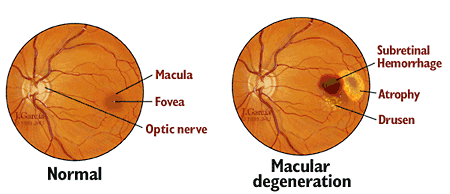Age-Related Macular Degeneration: Symptoms, Causes, Treatment
What are the symptoms of age related macular degeneration?
Age-related macular degeneration (AMD) affects the macula, which is the central part of the retina responsible for sharp central vision. The symptoms of AMD can vary depending on the stage of the disease but may include:
- Blurred or distorted vision: Straight lines may appear wavy or crooked, and central vision may be blurry.
- Dark or empty areas in central vision: You may notice a blank or dark spot in the center of your vision.
- Difficulty seeing in dim light: Your ability to see in low light conditions may be reduced.
- Decreased contrast sensitivity: Colors may appear less vivid, and it may be harder to distinguish between shades of colors.
- Difficulty recognizing faces: Faces may become harder to recognize, especially in the central field of vision.
- Straight lines appearing curved or distorted: This is often a sign of macular damage.
- Slow recovery of visual function after exposure to bright light: Your eyes may take longer to adjust to changes in lighting conditions.
It’s important to note that early AMD may not have noticeable symptoms, so regular eye exams are crucial, especially if you are at risk for AMD due to age, family history, or other factors.
What are the causes of age related macular degeneration?
The exact causes of age-related macular degeneration (AMD) are not fully understood, but several factors are believed to contribute to the development of the condition. These include:
- Age: The risk of AMD increases with age, particularly after the age of 50.
- Genetics: A family history of AMD increases your risk of developing the condition.
- Smoking: Smoking is a significant risk factor for AMD and can increase the likelihood and severity of the disease.
- Diet: A diet high in saturated fats and low in antioxidants and certain nutrients (such as vitamin C and vitamin E, zinc, copper, and lutein/zeaxanthin) may increase the risk of AMD.
- Cardiovascular disease: Hypertension, high cholesterol, and other cardiovascular risk factors may contribute to the development of AMD.
- Light exposure: Chronic exposure to ultraviolet (UV) light and blue light may play a role in the development of AMD.
- Race: Caucasians are more likely to develop AMD than other racial or ethnic groups.
- Gender: Women appear to be at a higher risk for AMD than men.
- Obesity: Being overweight or obese may increase the risk of AMD.
- Heredity: Certain genetic factors have been linked to an increased risk of AMD.
While these factors are associated with an increased risk of developing AMD, not everyone with these risk factors will develop the condition, and some people without these risk factors may still develop AMD. Regular eye exams and lifestyle modifications can help reduce the risk of developing AMD and manage the condition if diagnosed.
What is the treatment for age-related macular degeneration?
Treatment for age-related macular degeneration (AMD) depends on the type and severity of the condition. There are two main types of AMD: dry AMD and wet AMD.
- Dry AMD: Currently, there is no treatment that can reverse the damage caused by dry AMD. However, certain lifestyle changes, such as quitting smoking, eating a healthy diet rich in antioxidants and omega-3 fatty acids, maintaining a healthy weight, and protecting your eyes from UV light, may help slow the progression of the disease.
- Wet AMD: Wet AMD is characterized by the growth of abnormal blood vessels beneath the retina. Treatment for wet AMD may include:
- Anti-VEGF therapy: This involves injections of medications that help reduce the growth of abnormal blood vessels and can help stabilize or improve vision in some cases.
- Laser therapy: In some cases, laser therapy may be used to destroy abnormal blood vessels and reduce the risk of vision loss.
- Photodynamic therapy: This involves a combination of a light-activated drug and laser therapy to target abnormal blood vessels.
- Surgery: In certain cases, surgery may be recommended to remove blood or scar tissue from the eye.
It’s important to note that early detection and treatment are crucial for managing wet AMD and minimizing vision loss. Regular eye exams are essential, especially if you are at risk for AMD due to age, family history, or other factors. Your eye care professional can recommend the most appropriate treatment based on your specific condition and needs.
TL;DR: Age-Related Macular Degeneration
Age-related macular degeneration (AMD) is an eye disease that affects the macula, the central part of the retina responsible for sharp, central vision.
Here are some key points about AMD:
- Leading cause of vision loss in older adults: AMD is a major cause of vision impairment and blindness in people over the age of 60 in developed countries.
- Dry and wet forms: There are two main types – dry AMD and wet AMD. Dry AMD is more common and involves the gradual breakdown of macula cells. Wet AMD is less common but more severe, caused by abnormal blood vessel growth under the macula that can leak fluid and blood.
- Central vision loss: AMD primarily affects the central vision needed for activities like reading, driving, and recognizing faces. Peripheral or side vision is usually unaffected.
- Risk factors: Age is the biggest risk factor. Other risks include smoking, obesity, family history, race (more common in Caucasians), and certain dietary factors.
- Symptoms: Early AMD may have no symptoms. As it progresses, symptoms can include blurred or distorted central vision, need for brighter light, and blind spots in the center of vision.
- Treatment: There is no cure, but treatment can delay vision loss. For wet AMD, anti-VEGF drugs that inhibit new blood vessel growth can help. Vitamins, minerals, and avoiding smoking may help dry AMD.
Early detection through regular eye exams is crucial, as AMD progresses slowly, and prompt treatment can potentially slow vision loss significantly.




